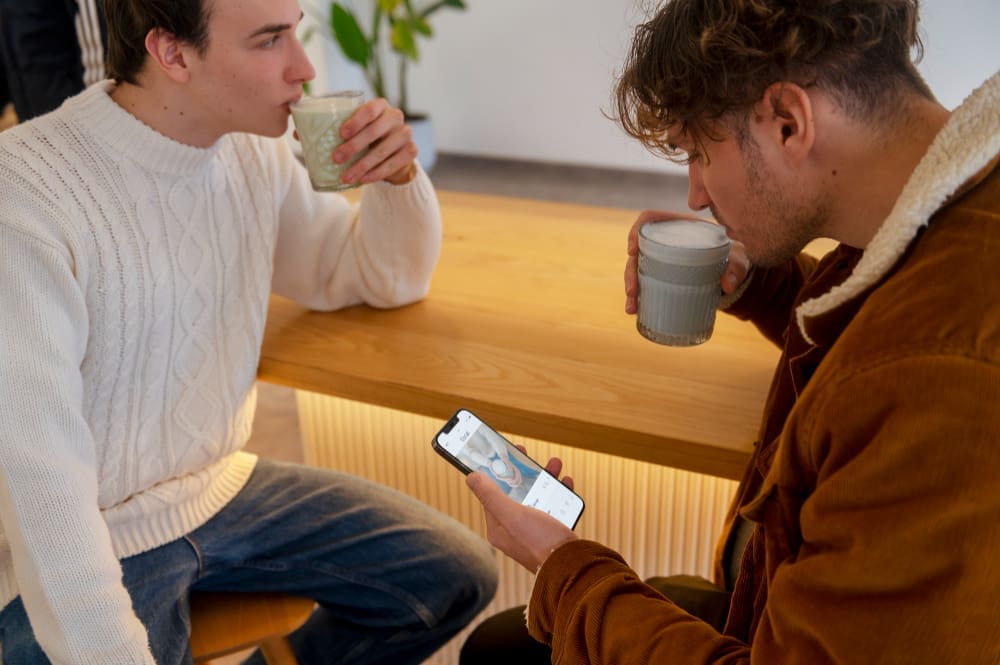Ever noticed the way some people just seem to have it all together without even uttering a word? It’s not magic—it’s non-verbal communication at work. These silent signals speak louder than you’d think, reshaping how others see you, and ultimately, how you see yourself.
Improving your life doesn’t always require grand changes or endless talking. Sometimes, it’s the simple, non-verbal habits that can create profound shifts. Let’s delve into these overlooked strategies that tap into the powerful, instinctive world of body language and presence.
1. Harnessing Non-Verbal Charm

We often underestimate the power of non-verbal cues. You might think words are your main tool for expression, but did you know that over half of our communication isn’t verbal at all? In fact, research suggests that body language, facial expressions, and tone of voice convey more meaning than the actual words we use.
When you hold someone’s gaze, it signals both attention and respect. Eye contact fosters a sense of intimacy and trust, allowing the other person to feel seen and valued. Similarly, standing with confidence—shoulders back, head held high—projects a sense of self-assuredness that can be contagious. People are naturally drawn to confident individuals, often feeling more at ease and encouraged to engage in open dialogue.
Additionally, utilizing a warm and compassionate tone can create an inviting atmosphere. Your tone conveys emotions that words alone might not fully express. A gentle, soothing voice can put others at ease, while an enthusiastic tone can inspire excitement and connection. This emotional undertone reinforces the message that you are genuinely interested in the interaction, fostering a bond that encourages more genuine exchanges.
Beyond just these actions, the subtleties of gestures play a crucial role in harnessing non-verbal charm. Simple gestures, such as nodding affirmatively while someone is speaking or leaning slightly forward, can convey attentiveness and empathy. These non-verbal signals help to transform interactions from awkward and uncertain to welcoming and open, effectively bridging the gap between individuals and helping you connect more sincerely and effectively.
2. Navigating Social Situations with Ease

Remember the chaotic feeling of disembarking from a plane? The rush to grab luggage and exit can often lead to frayed nerves and impatience. However, this everyday scenario presents an invaluable lesson in patience and respect, showcasing the impact of non-verbal communication in social situations.
When you choose to wait your turn instead of rushing past others, you demonstrate respect and awareness, qualities that are often overlooked in our fast-paced lives. This simple act of patience—standing still, making eye contact with those around you, and even offering a friendly smile—conveys a silent message of consideration. It illustrates that you value not only your time but also the time of those around you. This kind of behavior can drastically shift the atmosphere of a crowded environment, transforming it from one of tension to one of cooperation and goodwill.
Furthermore, allowing someone to go ahead of you in line or letting a fellow traveler pass while boarding a bus or train is more than just a courteous gesture; it sets a powerful, positive tone for the interaction. Such non-verbal cues create a ripple effect—others are likely to notice and may feel inclined to reciprocate this kindness, promoting an environment of mutual respect and friendliness. Small gestures of this nature, such as smiling or nodding in acknowledgment, help foster connections, even with strangers.
Navigating social situations with ease also extends to how you carry yourself within these contexts. Your body language can communicate openness and approachability. Standing tall, with arms relaxed by your sides, makes you more inviting than when you are closed off with crossed arms or a tense posture. By embodying a calm and composed demeanor, you create space for positive interactions, making it easier for others to engage with you.
3. The Downside of Divided Attention

Have you ever been on a date with someone who spends more time looking at their phone than at you? Frustrating, right? This experience highlights a critical issue in our modern communications landscape. Phone distraction is not just disrespectful; it sends a powerful non-verbal signal that whatever is on the screen takes precedence over the person sitting across from you. This dynamic can lead to feelings of neglect and diminishes the emotional connection that is often vital in building meaningful relationships.
When we choose to prioritize our devices over face-to-face interactions, we inadvertently create barriers that hinder genuine connection. The act of continuously checking notifications, scrolling through social media, or responding to messages communicates disengagement. It implies that our attention is fragmented, suggesting that the conversation can wait while something seemingly more urgent takes its place. This divided attention can leave others feeling undervalued, leading them to question their importance in the interaction.
To counteract this tendency, making a conscious effort to put down your phone and engage fully with those around you can transform your social experiences. By turning your device face down or tucking it away, you signal that you are present and fully invested in the moment. This simple act of mindfulness conveys an unspoken message that you value the interaction and are attentive to the person in front of you. Eye contact, active listening, and responsive body language can significantly enhance the quality of your conversations, creating a more rewarding experience for both parties.
In an era where technology tends to dominate, prioritizing face-to-face interactions is not only refreshing but also profoundly rewarding. The richness of human connection thrives on the nuances of non-verbal communication—like smiles, nods, and gestures—that are all too easily overlooked in our digital world. Engaging fully allows for deeper emotional exchanges and shared experiences that strengthen bonds and showcase our authenticity.
4. Cultivating a Mindful Presence

Being present is one of the most powerful non-verbal ways to connect with others. In our fast-paced, distraction-filled world, where our attention is often pulled in multiple directions, cultivating a mindful presence can be a transformative practice. When you embrace mindfulness, you not only enhance your own emotional well-being but also create a ripple effect that positively impacts those around you.
Practicing mindfulness means actively engaging with your surroundings and fully embracing the moment at hand. This could involve focusing intently on a conversation, giving your full attention to the person speaking, or immersing yourself in the ambiance of your environment—whether that’s taking in the sounds of nature during a walk, savoring the aromas of a meal, or appreciating the warmth of sunlight streaming through a window. It’s about being intentionally aware of what is happening in the here and now.
Simple actions can significantly deepen your connections with others. Listening intently—truly hearing what someone has to say without formulating your response while they speak—signals that you value their thoughts and feelings. Nodding in acknowledgment or maintaining appropriate eye contact fosters an atmosphere of trust and receptivity. These small gestures can transform everyday exchanges into meaningful interactions and help build rapport.
Moreover, when you embody a mindful presence, you create a safe space for others to express themselves. People are more likely to open up and share their vulnerabilities when they feel truly seen and heard. This deepens emotional connections and encourages a culture of authenticity and empathy.
5. Using Space Wisely

Proxemics, or the use of personal space, plays a significant role in non-verbal communication and can greatly influence how we interact with others. Understanding and respecting boundaries while simultaneously being open to proximity can make a substantial difference in the quality of our connections. Personal space varies from culture to culture and even between individuals, so being attuned to these nuances is essential in fostering effective communication.
When you approach someone with a friendly demeanor, while consciously maintaining an appropriate distance, you create an inviting atmosphere that encourages openness and dialogue. For instance, standing too close can make others feel uncomfortable or threatened, while standing too far away might convey disinterest or aloofness. Striking the right balance is key; it allows you to signal that you are approachable and willing to engage, without overstepping their personal boundaries.
On the other hand, your body orientation and stance can also significantly impact how others perceive you and whether they feel inclined to approach you. Adopting a confident stance—standing tall with an open posture and making eye contact—projects self-assurance and approachability. This non-verbal cue invites others to come forward, creating opportunities for meaningful interactions and exchanges.
Being mindful of the space you occupy and how you position yourself can promote a sense of comfort and safety in social settings. For instance, if you’re in a group conversation, angling your body toward the speaker demonstrates your engagement and respect for their input. Conversely, positioning yourself away can signal disinterest or disengagement.
Prioritizing Others in Everyday Interactions
Life is busy, but making an effort to prioritize others in small, everyday situations can be remarkably rewarding. Whether it’s letting another driver merge in traffic or holding a door open, these non-verbal cues of consideration make a big impact.
People tend to notice and appreciate gestures that show they’re valued, even if they never say so directly. Establishing this habit can influence not only your personal moods but also the broader social environment you inhabit.
Why Non-Verbal Habits Matter
The power of non-verbal habits lies in their ability to transform your relationships and environments effortlessly. These habits include making eye contact, offering understanding smiles, and demonstrating patience. Each interaction builds on the last, gradually enhancing your likability and influence.
Incorporating these subtle signals into daily life changes how people perceive you, often leading to more fulfilling connections and professional opportunities.
Empathy Through Action
While it’s easy to be self-focused, practicing empathy—especially through non-verbal cues—is critical. Empathetic actions invite trust and form an unspoken bond with others.
By identifying and responding to others’ needs—like offering a comforting touch or understanding nod—you convey support. This helps reinforce your role as a compassionate ally in both personal and professional spheres.
Empathy, expressed through actions rather than words, is a dynamic tool for nurturing healthier, more rewarding relationships.
Lessons from the Limbic System
The limbic system, a unique part of your brain, dictates much of your emotional world and how it’s shared non-verbally. These unconscious signals, whether of comfort or tension, can affect outcomes in unexpected ways.
Being mindful of your bodily signals, like maintaining a relaxed posture, remaining non-confrontational, or avoiding nervous habits, can shape and enhance interactions in powerful ways.
Such awareness allows you to manage impressions more effectively, paving the way for improved personal connections and professional relations.
Reciprocity in Communication
Human interactions are inherently reciprocal. When you treat others with warmth and generosity through your non-verbal cues, it often comes back to you.
Such reciprocal behavior reinforces positive relationships and can ripple into personal and professional realms, enriching your world.
This strategy doesn’t only enhance individual relationships; it helps foster a community of kindness and respect, benefiting everyone involved.
Conscious Choices in Communication
Consider this moment: choosing to smile or acknowledging someone with a nod might seem small, but it can change the course of a conversation.
Each choice you make in your non-verbal communication strengthens your presence and encourages others to respond in kind.
Once you realize the impact of these choices, you can more deliberately shape your interactions to be positive and meaningful.
The quiet power of non-verbal habits can transform your daily life. Practice these subtle, effective ways of communicating, and watch as your world becomes more connected and enriching.







